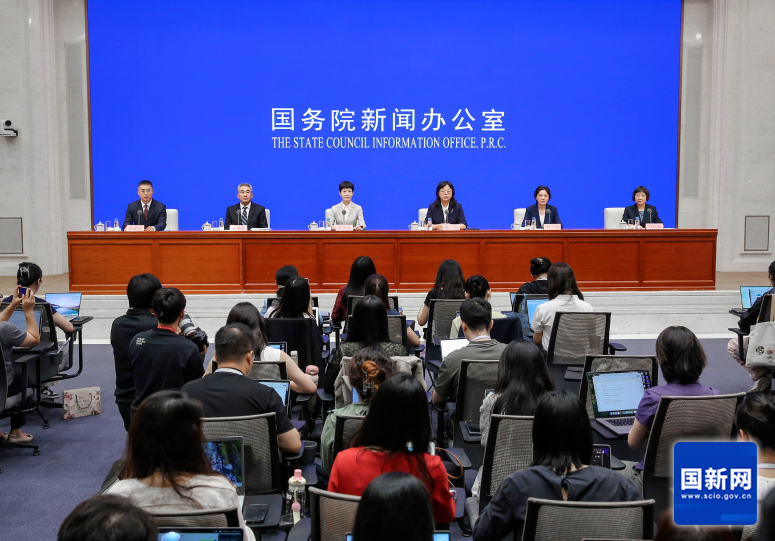On July 30, China’s State Council Information Office held a press conference to announce a nationwide childcare subsidy scheme, aiming to alleviate the burden on families and encourage childbirth. The new policy, taking effect on January 1, 2025, will offer RMB 3,600 per child annually for all legally born children under the age of three.
Officials from the National Health Commission (NHC), Ministry of Finance (MOF), National Healthcare Security Administration (NHSA), and All-China Federation of Trade Unions (ACFTU) shared key details and fielded media questions.
According to Guo Yanhong, Deputy Director of the National Health Commission, the key points of the implementation plan include:
1. Subsidies issued under this policy will be exempt from personal income tax, and will not be counted as household income when determining eligibility for minimum living standards or poverty assistance programs.
2. The childcare subsidy policy will take effect on January 1, 2025.
3. Eligible recipients are children under the age of 3, born in accordance with the law.
4. The subsidy will be RMB 3,600 per child per year, issued annually until the child turns 3.
5. Either parent or a legal guardian may apply.
6. Applications will be processed primarily through the online childcare subsidy management system, with offline options also available.
7. Subsidy funds will be transferred to the applicant’s or child’s bank account or financial account.
When and how can families apply?
Wang Haidong, Director of the Department of Population and Family at the NHC, explained that application portals across all regions will gradually open in late August, with full nationwide availability by August 31, 2025.
Applicants can apply:
- Online, via the national childcare subsidy information system
- Through third-party platforms like Alipay and WeChat
- Or offline, at the child’s registered township or street office
Only essential documents such as the child’s birth certificate and household registration (hukou) are required to prove identity and guardianship.
From the Ministry of Finance, Guo Yang (Director of the Department of Social Security) added that:
- A new fiscal transfer project will be established under the central government’s shared financial responsibility.
- The central government has allocated a preliminary budget of RMB 90 billion for 2025.
- Local regions with higher existing subsidy standards may continue their policies after proper evaluation and registration.
Q&A Session Highlights from the Press Conference
Q: The childcare subsidy applies to children under age 3. Why was this age group chosen? Can children born before 2025 still receive the subsidy? Who is eligible to apply?
A: Wang Haidong, Director of the Department of Population and Family, National Health Commission (NHC)
The focus on children under age 3 is based on scientific evidence that this is a critical stage for early childhood development and when families need the most support. Offering support to families during this phase is also a globally accepted practice.
According to the implementation plan, subsidies will begin on January 1, 2025, for all legally born children under the age of 3, until they reach 3 years old. This includes children born before 2025, as long as they have not yet turned 3 by January 1, 2025. These children will receive prorated subsidies for the remaining months until they turn 3. In essence, children born after January 1, 2022, are eligible if they meet the legal conditions.
The subsidy application is household-based. Each household designates one applicant, who should be one of the child’s parents or, in special cases, a legal guardian.
We will guide local governments to integrate this policy with services such as maternal care, childbirth hospitalization, child immunization, health checkups, hukou registration, and social security card issuance, to promote public awareness and ensure all eligible children benefit from the subsidy.
Q: The subsidy is set at RMB 3,600 per child per year. How was this figure determined, and what are the expected outcomes?
A: Guo Yanhong, Deputy Director, National Health Commission
The amount of RMB 3,600/year per child was determined based on the cost of raising children in today’s China, national fiscal conditions, and by referencing international practices. The principle was to do the best within our means.
The policy is expected to bring three major benefits:
- Relieve family burdens:
The subsidy directly increases household income and will benefit millions of families annually, providing foundational economic support and easing financial pressures of childrearing. - Promote a family-friendly atmosphere:
As an incentive policy, the subsidy encourages childbirth and supports integration with other policies (childcare, education, employment, housing, taxation) to foster a holistic, birth-friendly society. - Strengthen social welfare:
This is a universal, foundational, and inclusive welfare measure. By investing in people, it enhances basic services and improves the quality of life for families. It also promotes a positive cycle between social welfare and economic growth.
This policy is still new, and we will continue to research, collect feedback, and adjust the implementation based on practical results.
Q: As this is a significant welfare policy requiring steady funding, what measures will the Ministry of Finance take to ensure implementation?
A: Guo Yang, Director of the Department of Social Security, Ministry of Finance
We understand the importance of ensuring accurate, timely, and full disbursement of subsidies to families. Our key measures include:
- Creating a dedicated transfer payment system:
A special budget line called “Childcare Subsidy Support Fund” has been established with an initial budget of RMB 90 billion. The central government will fund 90% of the standard subsidy, showing strong commitment and supporting local capacity. - Enhancing financial management and oversight:
The implementation plan emphasizes simplicity, transparency, and efficiency. We are also preparing guidelines on fund use and performance tracking, in collaboration with the NHC. This will ensure fiscal responsibility and proper fund allocation. - Clarifying tax and social benefit exemptions:
Subsidies are exempt from personal income tax and will not be counted toward income when assessing eligibility for minimum income guarantees or hardship aid. This complements existing tax relief policies such as RMB 2,000/month deductions for children under 3.
Currently, local finance departments are calculating and preparing fund allocations. This policy reflects a key directive from China’s central leadership, and we will work closely with the NHC to monitor every step of the process and safeguard every subsidy payment.
Q: Beyond the childcare subsidy, what other fertility support measures has the Ministry of Finance introduced?
A: Guo Yang, Director, Department of Social Security, Ministry of Finance
In recent years, following central government directives, the Ministry of Finance has collaborated with multiple departments to improve birth support across the entire fertility and parenting cycle, covering childbirth, parenting, education, healthcare, and housing. Key efforts include:
- Improving prenatal and maternal health services:
- 2025 budget includes RMB 5.52 billion for maternal health checkups, postnatal visits, and newborn care.
- RMB 370 million allocated for birth defect screening and prevention.
- Enhancing maternal and child healthcare:
- RMB 5.22 billion for free vaccinations and mother-to-child disease prevention.
- RMB 1.11 billion to improve pediatric and neonatal care and train medical staff.
- Urban-rural health insurance subsidies raised to RMB 700 per person/year in 2025.
- Expanding affordable childcare services:
- Since 2023, RMB 3 billion has supported inclusive childcare demonstration programs.
- Funds also support vocational training for childcare workers (nannies, caregivers).
- Tax incentives offered to families and institutions providing childcare services.
- Education and housing support:
- Increased investment in public education and quality resources.
- More affordable rental housing for families with multiple children.
- Higher housing loan limits for multi-child households.
We’ll continue strengthening fiscal inputs, optimizing policy tools, and coordinating across sectors to build a fertility-friendly society.
Q: What progress has been made in building a fertility-friendly policy system?
A: Guo Yanhong, Deputy Director, National Health Commission
In 2023, the State Council issued a plan proposing 13 integrated fertility support measures across four categories. Results have been positive:
- Economic support:
- RMB 2,000/month tax deduction for children under 3.
- Improved maternity expense coverage and broader insurance reach.
- Parental leave:
- Maternity leave extended to 158+ days in most provinces.
- 15 days of paternity leave and 5–20 days of parental leave added.
- Childcare services:
- Inclusive childcare supply expanded significantly.
- Integrated daycare and preschool models developed.
- By end of 2024, China had 4.08 daycare spots per 1,000 population.
- Maternal and child health:
- Improved access to painless labor, maternal safety programs.
- In 2024, maternal mortality dropped to 14.3 per 100,000, infant mortality to 4.0‰, among best globally (WHO-rated top 10).
- Pediatric care expansion:
- All secondary and tertiary public hospitals now provide pediatric services.
- Education and housing:
- Promoted balanced compulsory education, eased homework and tutoring burden.
- Launched free preschool education pilot programs.
- Supported same-school enrollment for siblings.
- More public housing for multi-child families.
We will keep refining and expanding these measures to reduce the overall burden of childbirth, parenting, and education.
Q: What role has the All-China Federation of Trade Unions (ACFTU) played?
A: Liu Hongmei, Director, Women Workers Department, ACFTU
We are deeply engaged in implementing fertility-friendly workplace policies:
- Protecting women’s rights:
- Participated in a nationwide inspection of maternity protections across 86,000 employers.
- Helped draft local labor laws ensuring maternity leave and workplace safety.
- Ran public education campaigns, reaching over 20 million people.
- Supporting workplace childcare:
- From 2022–2024, funded RMB 22.5 million in grants to 300 employers offering daycare services.
- Allowed companies to allocate welfare funds for in-house childcare.
- Hosted national childcare skills competitions.
- Creating family-friendly work environments:
- Issued guidelines for “Six Friendly Standards,” including career support, parental leave, and workplace wellness.
- Built breastfeeding rooms and hosted staff matchmaking events to promote work-life balance.
We will continue cooperating with national agencies to expand service coverage and improve workplace support for families.
Q: What has the National Healthcare Security Administration (NHSA) done to strengthen maternity insurance?
A: Liu Juan, Director of Benefits, NHSA
The NHSA has made substantial improvements to China’s maternity insurance system:
- Expanded coverage:
- As of June 2025, 253 million people enrolled, including freelancers, migrant workers, and gig economy workers.
- Improved benefits:
- Full-cycle coverage from pregnancy to childbirth.
- Maternity medical costs reimbursed, maternity leave allowances paid via insurance funds.
- From 2021–2025, over 96 million people received benefits, with RMB 438.3 billion paid out.
- New benefit types:
- All 31 provinces now cover assisted reproductive technologies (ART).
- Some areas reimburse for painless childbirth.
- Pilots for newborn care and father participation programs under way.
- Better service delivery:
- “One-click newborn enrollment” pilot allows newborns to gain coverage using birth certificates.
- Faster processing: maternity allowance applications are completed within 10 working days.
- Over 60% of cities now pay allowances directly to families, ensuring timely financial support.
We remain committed to policy innovation and system improvement to help families feel secure in growing their households.




